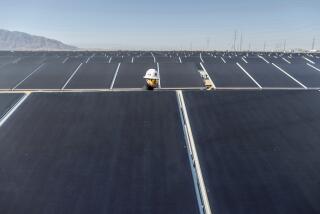Renewable power trumps fossil fuels for first time
Renewable energy is surpassing fossil fuels for the first time in new power-plant investments, shaking off setbacks from the financial crisis and an impasse at the United Nations global warming talks.
Electricity from the wind, sun, waves and biomass drew $187 billion last year compared with $157 billion for natural gas, oil and coal, according to calculations by Bloomberg New Energy Finance using the latest data. Accelerating installations of solar- and wind-power plants led to lower equipment prices, making clean energy more competitive with coal.
“The progress of renewables has been nothing short of remarkable,” United Nations Environment Program Executive Secretary Achim Steiner said in an interview. “You have record investment in the midst of an economic and financial crisis.”
The findings indicate the world is shifting toward consuming more renewable energy even without a global agreement on limiting greenhouse gases. Delegates from more than 190 nations converge in Durban, South Africa, on Nov. 28 to discuss new measures for limiting emissions damaging the climate.
The renewables boom, spurred by about $66 billion of subsidies last year, intensified competition between wind- turbine and solar-panel manufacturers, gutting margins from the biggest producers led by Vestas Wind Systems A/S and First Solar Inc. The 95-member WilderHill New Energy Index of renewable- energy stocks has tumbled 40 percent this year, steeper than the 14 percent drop in the MSCI World Index.
The zeal to replace fossil fuels, which take millions of years to form from dead organic matter, belies the failed efforts at the UN talks to broker a deal that would limit carbon dioxide emissions from coal and oil blamed for global warming. Without a deal, existing pollution caps under the 1997 Kyoto Protocol expire next year.
The talks on the future of Kyoto were deadlocked after existing members Russia, Canada and Japan said they won’t make new emissions targets after 2012 because the accord doesn’t set limits for the three biggest polluters: the U.S., which never ratified it, and developing nations China and India.
“Hopes have been ratcheted down,” said Daniel Yergin, chairman of IHS Cambridge Energy Research Associates. “The notion that there is going to be a global compact on this have been pushed back,” said the author of “The Prize,” a history of the oil industry that won him a Pulitzer Prize in 1992.
Bewildering’ Rules
The wind-energy industry is now more focused on the “sometimes bewildering variety of domestic and regional policies” than on the UN negotiations as a source of impetus for growth, said Steve Sawyer, secretary-general of the Brussels-based Global Wind Energy Council.
As well as renewables spending exceeding that on new fossil plants, last year also was the first time expenditure in developing countries, mainly China, exceeded that in the industrialized world, Sawyer said, predicting both trends will continue.
The New Energy Finance figures exclude investment that merely replaces existing plants, and its renewables tally excludes money spent on building large hydropower projects.
Wind operators are likely to install 43 gigawatts of generating capacity this year and 48 gigawatts next year, up from 36 gigawatts in 2010, GWEC estimates.






